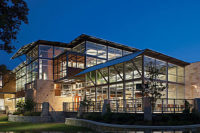“The building was designed as the first Whole Foods Market in Oklahoma City and is emblematic of the company’s values and commitment to sustainability,” said Felicia Dunham, Associate of Mark Cavagnero Associates of San Francisco, CA.
The selection process
“The building is located on a site with a park and creek to the north, the Chesapeake Energy Campus to the east, and the other tenants in the Classen Curve retail district to the south and west,” Dunham explained. “The design of the building had to be appealing from all sides, and the materials selection was integral to this effort.”
Employing natural stone in this project was an obvious choice for Dunham and her team. Since both the developer and Whole Foods were looking for quality durable materials that would weather well in the Oklahoma City climate, natural stone proved to be perfect — especially paired with pre-weathered zinc siding.
Ultimately, Dunham and the team selected New York Bluestone in the “Blue Select” range, supplied by Richburg Stone & Supply Co. in Oklahoma City and quarried by Johnston & Rhodes Bluestone Co. of East Branch, NY.
The Bluestone was specified with a natural cleft finish, and it was used as cladding for the building’s extended, sweeping walls, as well as the site walls. According to the architect, the stone was utilized in an ashlar pattern with uniform coursing, which was chosen to reference the brick masonry cladding of the neighboring developments.
“The same Bluestone was used as paving at the terrace and indoor-outdoor seating area,” Dunham added. “In addition, the paving stone was specified with a thermal finish, which is more appropriate for use as a walking surface.”
Implementing the design
Whole FoodsOklahoma City, OK |
|
Architect: Mark Cavagnero Associates, San Francisco, CA Executive Architect: Elliott + Associates, Oklahoma City General Contractor: Smith & Pickel Construction, Oklahoma City Stone Supplier: Richburg Stone & Supply Co., Oklahoma City
Stone Quarrier: Johnston & Rhodes Bluestone Co., East Branch, NY |
Designing the exterior of the Whole Foods Market to be compatible with both the red brick structures on the Chesapeake Energy campus — as well as the modern manganese brick and glass buildings of Classen Curve — was an important consideration in the choice of zinc and Bluestone for the exterior skin. Before deciding on the Bluestone, Dunham and her team considered many stone types and patterns for the project, including various limestones and sandstones.
“The contractor produced mock-ups with different types of stone and different stone patterns; the Bluestone was preferred,” said the architect. “The natural cleft face produces an irregular texture on the surface as well as color variation from piece to piece to add interest. As a result, the ‘Blue Select’ range was chosen to limit the color variation, which can be extreme with Bluestone.”
Once the stone and pattern were selected, the challenges that Dunham’s team experienced were associated with the detailing. “Thought was given to the detailing of the expansion joints in order to minimize their appearance, and the outside corners were carefully detailed to transition gracefully from one surface or material to the next,” she said.
Because of the detailing challenges the team was faced with, they visited the site at key intervals during the construction to view the mock-ups and the construction progress. In addition, they also worked closely with the general contractor, Smith and Pickel, which performed daily supervision. Additionally, the Executive Architect, Elliott + Associates, was responsible for the balance of the development on the site.
The reaction to this new 47,000-square-foot structure was extremely positive. In the local community, the opening of the Whole Foods Market was much anticipated and very well received. “For Whole Foods, the Oklahoma City store has been very successful exceeding the anticipated demand,” Dunham said. “The disadvantage of working on projects so far from home is that you do not get to see firsthand how the project ages or gauge the lasting success of the design.”






